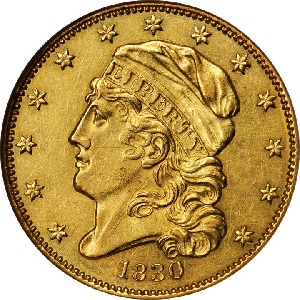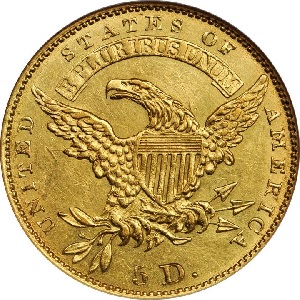1830 Capped Head $5 Half Eagle, Large 5D
The story of the 1830 Capped Head Large 5D $5 half eagle closely parallels that of 1830 Small 5D half eagle.
In the late 1820’s, the United States Mint in Philadelphia purchased a Rush & Muhlenberg coining press.(1) The new, powerful machine made it possible to use closed collars effectively for the first time. In essence, the closed collar acted as a die that imparted edge reeding at the same time the coin was being struck. Previously, reeding, or other edge ornamentation, was performed in a separate step prior to striking.(2)
The close collar also produced a more precise coin diameter, perfect centering, and a higher rim to slow wear and extend circulation life.
These technological advancements led to a diameter reduction (but no weight change) for the half eagle midway through 1829. Hence, there are some 1829 half eagles with a 25.0 mm diameter and others measuring 23.8 mm in width.(3)
1830 was the first full year of reduced diameter Capped Head half eagles. There are two major varieties: one variety has a large "5D" on the reverse and the other variety has a smaller "5D".
The mintage for the 1830 half eagle was 126,351, a respectable output for that era, but virtually all of them were melted down, seemingly as soon as they left the Mint.
Why were these half eagles and the vast majority of other early U.S. gold coins destroyed?
The Mint Act of 1792 set a rigid bimetallic value standard of silver to gold at 15 to 1 in the United States. Large discoveries of silver in Latin America, combined with wars on both sides of the Atlantic drove the free market ratio in Europe to more than 16 to 1. Under these conditions, the intrinsic metal value of all U.S. gold coins exceeded their face value, if sold in Europe.(4)
Speculators in the U.S. would buy one ounce of gold (in the form of coinage) for 15 ounces of silver, ship the gold to melting pots in Paris or London, and receive 16 ounces of silver in return, which was then sent back to the U.S. This cycle repeated itself until there were practically no gold coins circulating in the U.S. In an 1831 Paris incident, about 40,000 half eagles perished in one day.
Researcher and author John Dannreuther estimates only 25-35 examples remain today of the 1830 Large 5D variety. The Small 5D is just about as rare, with only 30-40 extant today.(5)
The Capped Head half eagle series of 1813-1834 is abounding with exceedingly rare and valuable dates, many of which qualified for the Key Date List of recommendations. Both 1830 varieties easily merit membership to that exclusive club. Their stellar records of price advancements speak for themselves!
| Estimated survivors in all grades: 35 ?
The survivor estimate from researcher John Dannreuther. |
| PCGS Rarity Scale: 8.8 ?
The 'PCGS CoinFacts Rarity Scale' assesses the relative rarity of all U.S. coins, based on estimated surviving examples. The scale runs from 1.0 to 10.0. The higher the number, the rarer the coin.
Learn more at PCGS. |
| Click HERE to check for availability on eBay** |
Preview of eBay selection (this one seldom comes up for sale, but you never know until you look):
 |
 |
| Trendline Avg = 18.61 | BETTER |
Historic Value Trend Charts:
| Last updated 8-7-24 | Return to Key Date Coin List | |
| Compare to Common Date Coin of Same Type | ||
|
|
||
| Download Charts to Your Computer | ||
Sources
1. Stack's Bowers Galleries. 1830 Capped Head Half Eagle. Small 5D. Aug 2019 Auction.
2. PCGS. Type 3, Capped Bust, Small Diameter.
3. Yeoman, R.S. and Garrett, Jeff, et al. A Guide Book of United States Coins, 75th ed. Pelham, AL: Whitman Publishing, 2021.
4. NGC. Capped Bust $5 (1807-1834).
5. Heritage Auctions. 1830 $5 Small 5D. Sep 2022 Auction.
**Many very fine coin dealers sell on eBay. At any point in time, there may be over one million search results for United States coins. This includes quite a few of the recommendations on our Key Date Coin List.
If you’re thinking about purchasing a rare coin, eBay is certainly worth a look. For your convenience, the links from this site to eBay are coded to bring up only coins certified by PCGS and NGC.
As is always, always the case, never buy a valuable coin from a seller whose trustworthiness cannot be verified. Learn more about this at our chapter Best Places to Buy Coins, which also has a section on doing business on eBay.
In the interest of full disclosure, Rare Coins 101 receives a small commission anytime someone connects to eBay from this site and purchases something.
Coin images by Stack's Bowers Galleries.


